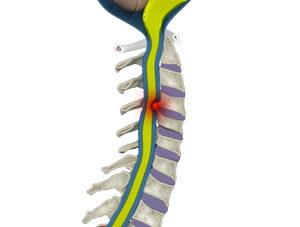Cervical Myelopathy

Introduction
The cervical nerves are large spinal nerves that branch from the spinal cord in the neck and travel into the arms, shoulders, upper back and hands where they control motor and sensory activities.
Cervical myelopathy refers to compression of the spinal cord due to narrowing of the vertebral canal in an area within the neck. This condition usually results in gradual loss of strength and coordination.
Causes
Cervical myelopathy may be caused by spinal stenosis due to arthritis, bone spurs or a tumor.
Signs and Symptoms
Cervical Spondylotic myelopathy (CSM) is the accurate term given to describe cervical myelopathy. Besides neck pain and stiffness, you may also experience weakness and numbness in the shoulder, arm, and fingers, loss of fine motor skills such as writing and picking up or holding small objects and problems with balance and coordination.
Diagnosis
To diagnose cervical myelopathy, your doctor will review your medical history, evaluate the signs and symptoms and perform a physical examination, including a neurological evaluation. Muscle strength, sensation as well as reflexes are tested. Your doctor will suggest certain diagnostic tests such as X-rays, CT or MRI scans, or myelography to provide better visualization of the anatomy of the intervertebral discs and spinal cord. Other tests that may be performed include electromyography to measure the electrical activity of the muscles and nerve conduction studies to evaluate the transmission of electrical signals as they move through a nerve.
Treatment
Some patients with cervical myelopathy can often be treated conservatively with anti-inflammatory and pain medications, muscle relaxants, spinal injections, physical therapy, braces to support the spine, traction, or acupuncture. Your doctor may recommend combining two or more treatment modalities to improve outcomes.
Surgery is usually recommended for patients with persistent pain, spinal instability or neurological dysfunction and involves removing parts of the bone or soft tissue causing the nerve or cord compression. Surgical techniques that may be employed include:
- Decompressive laminectomy is a surgical procedure in which a portion of the bone or lamina responsible for the compression is removed.
- Laminoplasty is a procedure that expands the size of the spinal canal releasing pressure over the spinal cord and nerve roots.
- Discectomy involves the removal of a herniated or ruptured disc from the affected region.
- Foraminotomy widens the neuroforamen where the nerves pass through relieving pressure over the compressed nerves.
- Spinal fusion is a surgical technique in which two or more vertebrae are joined together with the help of bone grafts and/or instrumentation such as rods, plates, screws, and interbody devices to improve stability.
These surgical procedures can be performed using minimally invasive techniques. Your surgeon will discuss surgical options and the associated risks and benefits and recommend the most appropriate procedure for you.







